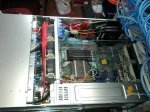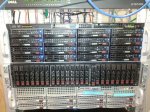louisk
Patron
- Joined
- Aug 10, 2011
- Messages
- 441
Okay, my first FreeNAS box is alive and I will post all the specs soon. I have a question. We talked about Pools of Vdevs and I thought I knew how that worked but now I am not sure. I have created 3 Vdevs of 4 disks each in Z2. Now I am not seeing how the next layer works that gives the clients a single target that is a stripe of the vdevs. Can you enlighten me?
Thanks,
Stephen
When you add vdevs to the pool, the striping is taken care of. ZFS stripes across all vdevs in a pool.


